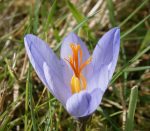 This perennial corm is native from southern Turkey to southwest Syria but found on rocky hillsides and open woods from North Africa to Palestine and Armenia. It is a member of the iris family, Iridaceae, that also includes gladiola, freesia, and crocosmia. The plant grows up to 4″ tall and has gray-green grass-like leaves. In the fall, slender, stemless flowers appear with a pale blue corolla marked with dark violet strips on the inside. Photo Credit Meneerke-Bloem Wikipedia
This perennial corm is native from southern Turkey to southwest Syria but found on rocky hillsides and open woods from North Africa to Palestine and Armenia. It is a member of the iris family, Iridaceae, that also includes gladiola, freesia, and crocosmia. The plant grows up to 4″ tall and has gray-green grass-like leaves. In the fall, slender, stemless flowers appear with a pale blue corolla marked with dark violet strips on the inside. Photo Credit Meneerke-Bloem Wikipedia
There are 15 or more kinds of crocuses in the Holy Land. Four of these grow in alpine and subalpine regions and rocky places in the montains of Lebanon (as well as elsewhere) which is a significant factor when considering Song of Song 6:4. In this passage a lover is comparing his beloved to cities but some autorities think that flowers are actually meant. Four flowers are suggested for the city Tirzah due to their presence in the area that inspired the writing of the passage: Crocus cancellatus var. damascenus, C. hyemalis, C. vitellinus, and C. zonatus (see entries for each of these species for further information)
Song of Songs 6:4 (NIV)
“You are as beautiful as Tirzah, my darling, as lovely as Jerusalem, as majestic as troops with banners.”
Crocuses like full sun and medium moist, well drained soil in USDA Hardiness Zones 3-8. They are susceptible to damage by slugs, snails, mice, voles, corm scab, and mosaic virus. Propagation is by seed and division. Crocuses are especially attractive when planted in large numbers in beds and borders and are a good choice for rock gardens, gravel gardens, and containers.
The genus name, Crocus, is from the Greek word κρόκος, krokos meaning thread and refers to the appearance of the stigmas. The specific epithet, cancellatus, is the Latin word meaning latticed, or cross-barred.